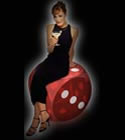Concept No.17: When you have made your low and are sure that you are getting quartered, you may have to throw away your hand.
Suppose you have an ace-deuce in your hand and the flop comes You are last to act, and five opponents ahead of you are betting, raising, and reraising.



In this situation, you probably should discard your hand. Notice that you have no high and obviously will be splitting the low with at least one other player
Concept No.18: When you play an ace-trey in a multiway pot and flop a low draw, it is often correct to throw away your hand.
This is one of those spots where you must play poker well. But if you have nothing else to go with your low draw, you probably should fold.
If you have some other good possibilities, be more inclined to play. For example, there might be a dozen cards that could turn to give you a straight draw for the nuts.
If this is the case, consider taking another card off. Otherwise, it is best to fold.
Concept No.19: There are some bluffing opportunities.
Here’s an example. Suppose the flop comes and there is a bet.



You sometimes can raise with virtually nothing. In a short-handed pot, your opponent might have bet an ace-ten figuring that you hold low cards. If you have a hand like




a raise is not unreasonable. Notice that your hand has a lot of ways to turn into a winner or a split. Also notice that this type of play works best in a short-handed pots. In pots with many players, it is best to never attempt such a bluff.
Concept No.20: You don’t have to push an ace-deuce.
Suppose on fourth street that you have an ace-deuce and nothing else, but you have the low hand made.
The action goes bet, call, call, and now it is your turn. You usually should just call in this situation, because a reraise by the original bettor can knock out the other callers.
However, whether to raise also depends on your judgment of the original bettor. For example, if he is a tight player who almost always goes for low, he probably has an ace-deuce.
If you have made a medium pair to go along with your low, his reraised could knock out everyone else, and you may win the high. Always remember to consider the play of the hand.
Another problem is that the last card might be an ace or a deuce to counterfeit you.
Concept No.20: On the end, it is sometimes incorrect to raise even when you have the nuts.
Here’s an example. Suppose that you are last to act in a four-person pot and the board is





If all you have is a wheel, you are probably against one or perhaps two other wheels, as well as a flush.
You may want to check if it is checked to you. And if there is a lot of action before it gets to you, depending on the pot odds, you might want to fold.
Concept No.22: On the end, you should raise with an ace-deuce in a four-handed pot but not in a three-handed pot.
If someone else also has an ace-deuce, you lose money by raising in a three-handed pot.
In a four-handed pot, you will break even. The exceptions to not raising in a three-handed pot are if you play well and are fairly sure that you are not against another ace-deuce, or if you are against an opponent who is extremely live.
Introduction / General Concepts / More Specific Ideas / Afterthought


